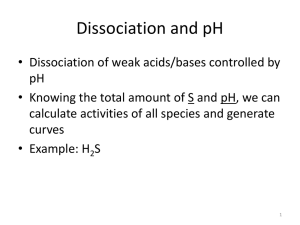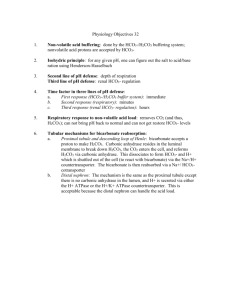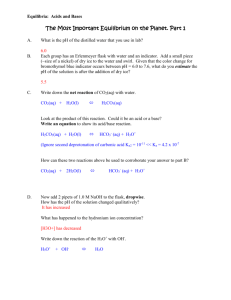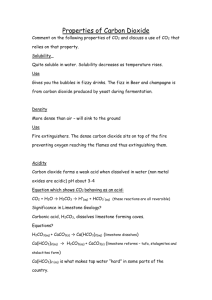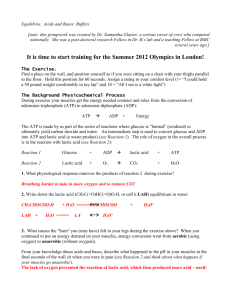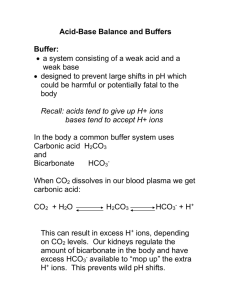1 Chapter 12: Acids and Bases: Ocean Carbonate System James
advertisement
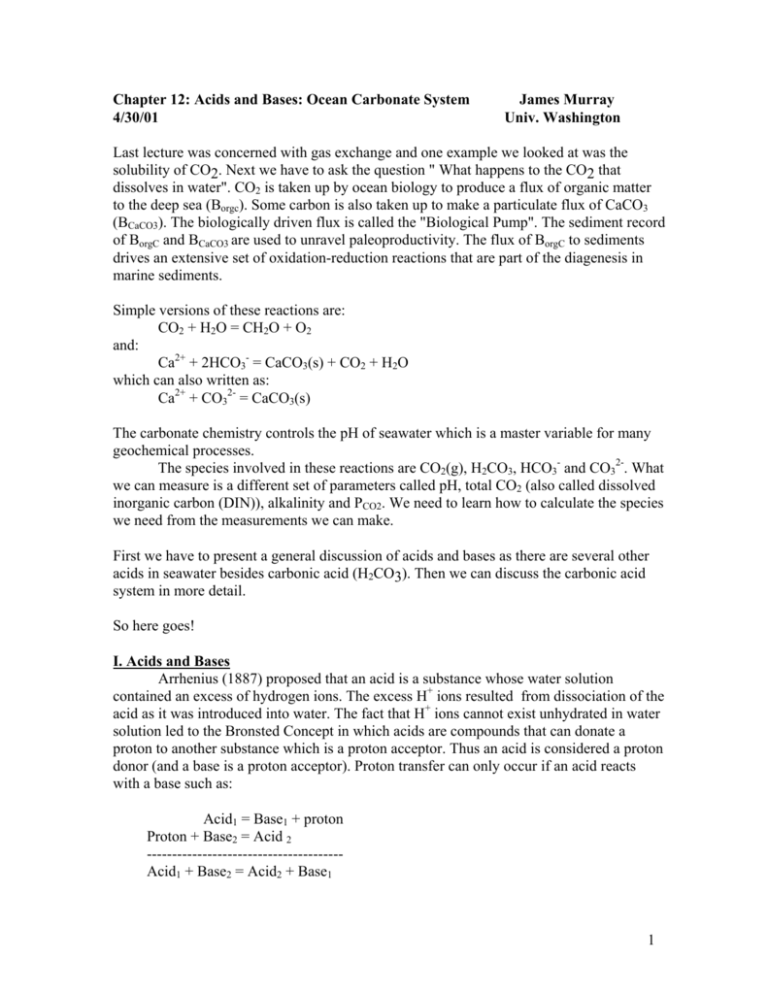
Chapter 12: Acids and Bases: Ocean Carbonate System
4/30/01
James Murray
Univ. Washington
Last lecture was concerned with gas exchange and one example we looked at was the
solubility of CO2. Next we have to ask the question " What happens to the CO2 that
dissolves in water". CO2 is taken up by ocean biology to produce a flux of organic matter
to the deep sea (Borgc). Some carbon is also taken up to make a particulate flux of CaCO3
(BCaCO3). The biologically driven flux is called the "Biological Pump". The sediment record
of BorgC and BCaCO3 are used to unravel paleoproductivity. The flux of BorgC to sediments
drives an extensive set of oxidation-reduction reactions that are part of the diagenesis in
marine sediments.
Simple versions of these reactions are:
CO2 + H2O = CH2O + O2
and:
Ca2+ + 2HCO3- = CaCO3(s) + CO2 + H2O
which can also written as:
Ca2+ + CO32- = CaCO3(s)
The carbonate chemistry controls the pH of seawater which is a master variable for many
geochemical processes.
The species involved in these reactions are CO2(g), H2CO3, HCO3- and CO32-. What
we can measure is a different set of parameters called pH, total CO2 (also called dissolved
inorganic carbon (DIN)), alkalinity and PCO2. We need to learn how to calculate the species
we need from the measurements we can make.
First we have to present a general discussion of acids and bases as there are several other
acids in seawater besides carbonic acid (H2CO3). Then we can discuss the carbonic acid
system in more detail.
So here goes!
I. Acids and Bases
Arrhenius (1887) proposed that an acid is a substance whose water solution
contained an excess of hydrogen ions. The excess H+ ions resulted from dissociation of the
acid as it was introduced into water. The fact that H+ ions cannot exist unhydrated in water
solution led to the Bronsted Concept in which acids are compounds that can donate a
proton to another substance which is a proton acceptor. Thus an acid is considered a proton
donor (and a base is a proton acceptor). Proton transfer can only occur if an acid reacts
with a base such as:
Acid1 = Base1 + proton
Proton + Base2 = Acid 2
--------------------------------------Acid1 + Base2 = Acid2 + Base1
1
For example:
HCl + H2O = H3O+ + ClH2O + H2O = H3O+ + OHH2CO3 + H2O = H3O+ + HCO3For example, in the first reaction, HCl transfers a proton to H2O.
Note that water (H2O), in the second reaction, can be both an acid (proton doner) and a
base (proton acceptor).
To simplify this presentation we will write acids as Arrhenius Acids, in which acids simply
react to produce excess hydrogen ions in solution. Such as:
HCl = H+ + Cla) Monoprotic Acids
Let's use acetic acid (CH3COOH) as an example of a monoprotic acid and we will
abbreviate it as HA. The base form (CH3COO-) will be A-.
We need to determine the concentrations of 4 species. These are the acid (HA) and base
(A-) forms of acetic acid and H+ and OH-. When there are four unknowns we need for
equations.
To simplify matters we will neglect activity corrections and assume that activities are equal
to concentrations ( ) = [ ]
The 4 key equations are:
1. The reaction
HA =
H+
+
AAcid Hydrogen Anion (or base)
2. Equilibrium Constant
K = (H+)(A-) / (HA)
where ( ) = activity
3. Mass balance on A
CA = [HA] + [A ]
(total concentration)
4. Charge Balance
[H+] = [A-] + [OH-]
(note that the mass and charge balances are written in terms of concentrations not
activities.)
pH (-log(H+)) is used as a master variable (e.g. the parameter against which other
concentrations are expressed) for acid-base reactions because it is the variable that
determines the distribution of acid and base forms. In addition it is easily measured.
One simple first question is, what is the distribution of the species HA, A-, H+ and OH- as
a function of pH?
We need to be able to solve for the concentration of these species. We can do this by two
methods. One is algebraic and one is graphical. For illustration these will be done by hand
2
but in practice you would use chemical equilibrium modeling programs like MINEQL+ or
HYDRAQL.
b) Algebraic Method
By combining equations 2 and 3 given above we can write algebraic expressions to solve
for the main species of acetic acid (HA) and acetate (A-).
[HA] = CT [H+] / K + H+
[A-] = CT K / K + H+
The equation for HA is derived using simple algebra as follows:
a. We start with: K = (H)(A)/(HA)
b. Rearrange the mass balance to solve for A = CT - HA and substitute for A in the
equilibrium expression.
c. We now have: K = (H)(CT - HA) / (HA)
d. Rearranging this equation gives: (HA) = (H)CT / (K + (H))
The equation for (A) is derived using the same approach but using HA = CT - A in step b.
For such calculations when you know K and the total concentration (CT) you can calculate
the concentration of HA and A- for any pH (or H+).
C) Graphical Approach
The approach is to construct a graph or distribution diagram showing how the
concentrations of all the species varies with pH. Such graphs are constructed using the
equations for HA and A given above. There are three regions for these graphs as discussed
below.
Assume:
K = 10-4.7 (this is the acidity equilibrium constant for acetic acid,
CH3COOH)
CT = 10-2
( ) = [ ] (e.g. activities equal concentrations, ignore activity corrections to
simplify this presentation)
If we make a plot of the concentration of each species as a function of pH there will be
three regions
a) pH = pK
(e.g. H+ = K ) (this pH is called the system point)
This condition is a point in the diagram. If we look at the equilibrium constant:
3
K = (H)(A)/(HA)
And rearrange it to:
K / (H) = (A) / (HA)
We see that when K = (H) the ratio on the left is equal to one and thus:
[HA] = [A-] = 1/2 CT
or in log form:
log [HA] = log [A-] = log CT - log 2 = log CT - 0.3
b) When pH << pK the solution is acidic and (H+) > K
For this condition the algebraic equations for HA and A can be simplified as follows:
log [HA] = log CT
(The line for HA has no slope and is equal to CT)
log [A] = log CT + log K - log H+
= log CT + log K + pH
δ log [A] / δ pH = +1
(The line for A has a slope of +1)
c) pH >> pK (e.g. basic solution, H+ << K)
log [A-] = log CT
log [HA] = log CT + log H+ - log K
log CT - pH - log K
δ log [HA] / δ pH = -1
The steps for constructing the graph are: 1) label axes, 2) draw a horizontal line for total
concentration, 3) locate system point, 4) note that the cross over is 0.3 log units below the
CT line, 5) draw lines for the species, 6) draw lines for H+ and OH-.
The lines for H+ and OH- can be obtained as follows. Write the acidity reaction for H2O.
H2O = H+ + OHKw = (H+)(OH-) / (H2O)
≅ (H+)(OH-)
The value of Kw = 10-14.
Thus:
Log (H+) + log (OH-) = -14.0
or
-pH + -pOH = -14.0
or
pH + pOH = 14.0
(because we can assume the activity of pure
water solvent is equal to one)
Thus at pH = 4.0, the pOH = 10.0
See example on the next page for acetic acid and water (Fig 12-1).
4
Fig. 12-1 Log-log distribution diagram for Acetic Acid showing the distributions of HA,
A-, H+ and OH- as a function of pH.
5
II. Apparent Equilibrium Constants
The difference between concentrations and activities can't be ignored for seawater and
chemical oceanographers often use a second approach.
Oceanographers frequently use an equilibrium constant defined in terms of concentrations.
These are called apparent or operation equilibrium constants. We use the symbol K' to
distinguish them from K. Formally they are equilibrium constants determined on the
seawater activity scale.
Apparent equilibrium constants (K') are written in the same form as K except that all
species are written as concentrations. The exception is H+ which is always written as the
activity (H+).
For the monoprotic acid HA we write:
HA = H+ + Aand
K' = (H+)[A-] / [HA]
The apparent equilibrium constants cannot be calculated from standard free energies of
reaction. They have to be determined experimentally in the lab. They must be determined
in the same medium or solution to which they will be applied. Thus if we need a value of
K' for the acid HA in seawater, someone must have experimentally determined the K for
the acidity reaction in a seawater solution with a known salinity (S) at the temperature and
pressure of interest. This sounds complicated, and it is. It is a lot of work but fortunately it
has been done for several important acids in seawater.
There are pros and cons for both the K and K' approaches.
When we use K the pro is that we can calculate the K from ∆Gr and one value can be used
for all problems in all solutions (one K fits all). The cons are that to use K we need to
obtain values for the free ion activity coefficients (γi) and the %free (fi) for each solution.
For K' there needs to have been experimental determination of this constant for enough
values of S, T and P that equations can be derived to calculate K' for the S, T and P of
interest. The good news is that when this has been done the values of K' are usually more
precise than the corresponding value of K. The other pro is that we do not need values of γi
and fi when we use K'.
6
Example 12-1:
The difference between K and K' can be illustrated by this simple example.
K = (H+)(A-) / (HA) = (H+)[A-]γT,A- / [HA] γT,HA
Rearrange to get:
K = (H+) [A-] γT,A- = K' γT,A[HA]
γT,HA
γT,HA
You see that the difference in magnitude of K and K' is the ratio of the total activity
coefficients of the base to the acid. If you know both K and K' , you can learn something
about the activity corrections.
For:
H2CO3 = HCO3- + H+
K1 = (HCO3-)(H+) / (H2CO3)
or
or
K1 = [HCO3-] γT,HCO3 (H+)
[H2CO3] γT,H2CO3
K1 = [HCO3](H+) γ T,HCO3
γT,H2CO3
[H2CO3]
= 10-6.3 from tables of ∆Gr° at 25°C and 1 atm
The value of K' has been determined for the same reaction. At S = 35, 25°C and 1 atm
K1' = [HCO3-] (H+) = 10-6.0
[H2CO3]
If we set K1 = K1' γT,HCO3 / γT, H2CO3
We can solve for γT,HCO3 / γT, H2CO3 = K1 / K1' = 10-6.3 / 10-6.0 = 10-0.3 = 5.0 x 10-1
Example 12-2:
We can compare this ratio with that obtained from the Garrels and Thompson speciation
model of surface seawater where:
γT,HCO3 / γT, H2CO3 = fHCO3 γHCO3
f H2CO3 γH2CO3
= (0.69)(0.68) = 4.1 x 10-1
(1.00)(1.13)
Not too bad. Not too good. These two estimates differ by about 20%. Is that good enough?
7
Table 12-1: The acids of seawater. The concentrations and apparent constants were taken
from Edmond (1970). Some elements form more than one acid.
Element
H2O
Reaction
H2O = H+ + OH-
mol kg-1
-logC
C
H2CO3 = HCO3- + H+
HCO3- = CO32- + H+
2.4 x 10-3
2.6
6.0
9.1
B
B(OH)3 + H2O = B(OH)4- + H+
4.25 x 10-4
3.37
8.7
Mg
Mg2+ + H2O = MgOH+ + H+
5.32 x 10-2
1.27
12.5
Si
H4SiO4 = SiO(OH)3- + H+
1.5 x 10-4
3.82
9.4
P
H3PO4 = H2PO4- + H+
H2PO4- = HPO42- + H+
HPO42- = PO43- + H+
3.0 x 10-6
5.52
1.6
6.0
8.6
S(VI)
HSO4- = SO42- + H+
2.82 x 10-2
1.55
1.5
F
HF = F- + H+
5.2 x 10-5
4.28
2.5
Ca
Ca2+ + H2O = CaOH+ + H+
1.03 x 10-2
1.99
13.0
pK'
13.9
And in anoxic systems
N
NH4+ = NH3 + H+
10 x 10-6
5.0
9.5
S(-II)
H2S = HS- + H+
HS- = S2- + H+
10 x 10-6
5.0
7.0
13.4
8
III. Carbonic Acid
Carbonic acid is the classic example of a diprotic acid and it can have a gaseous form. It
also can be expressed as open or closed to the atmosphere (or a gas phase)
There are 6 species we need to solve for:
CO2(g)
Carbon Dioxide Gas
Carbonic Acid (H2CO3* = CO2 (aq) + H2CO3)
H2CO3*
HCO3
Bicarbonate
CO32Carbonate
H+
Proton
OHHydroxide
To solve for six unknowns we need six equations.
Four of these are equilibrium constants. These are writen here as K but could also be
expressed as K'.
1. CO2(g) + H2O = H2CO3*
KH = (H2CO3*) / PCO2
(Henry's Law)
(note that gas concentrations are given
as partial pressure; e.g. atmospheric PCO2 = 10-3.5)
2. H2CO3* = H+ + HCO3K1 = (HCO3-)(H+) / H2CO3*)
3. HCO3- = H+ + CO32K2 = (H+)(CO32-) / (HCO3-)
4. H2O = H+ + OHKw = (H+)(OH-)
Representative values for these constants are given below. Equations are given in Millero
(1995) with which you can calculate all K's for any salinity and T, P conditions. The values
here are for S = 35, 25°C and 1 atm.
Constant
Thermodynamic Constant (K)
Apparent Seawater Constant (K')
KH
K1
K2
Kw
10-1.47
10-6.35
10-10.33
10-14.0
10-1.53
10-6.00
10-9.10
10-13.9
We can also define total CO2 (also referred to as DIC, CT or ΣCO2)
9
CT = [H2CO3*] + [HCO3-] + [CO32-]
IV. Construct a Distribution Diagram for H2CO3
a. First specify the total CO2 (e.g. CT = 2.0 x 10-3 = 10-2.7 M)
b. Locate CT on the graph and draw a horizontal line for that value.
c. Locate the two system points on that line where pH = pK1 and pH = pK2.
d. Make the crossover point, which is 0.3 log units less than CT
e. Sketch the lines for the species.
Boric Acid (B(OH)3) is another important acid is seawater (Table 12-1). Draw it on the
graph as well.
Use BT = 10-3.3 = 5.0 x 10-4 M and KB' = 10-8.7
With this graph you can locate the concentration of any of the required species at any pH.
The graph is shown in Fig 12-2.
At the pH of surface seawater (about pH 8.3) the main species is HCO3-. CO32- is next
followed by H2CO3.
10
Fig 12-2 Log-log distribution diagram of carbonic acid and boric acid in seawater.
11
V. Carbonate System Measurements
For our calculations, such as CO2 gas exchange or CaCO3 solubility, we want the
concentrations of H2CO3 or CO32-. We can not measure these species directly. The four
parameters that can be measured are pH, Total CO2, Alkalinity and PCO2.
a) pH
pH is defined in terms of the activity of H+ or as pH = -log (H+) = -log γH[H+}
The historical approach was to measure pH using a glass electrode calibrated with buffer
solutions prepared by the National Bureau of Standards. This is called the NBS Scale. The
NBS has now become the NIST. Thought the precisioon can be quite good (+0.003) the
accuracy is no better than about +0.02 because of several factors including the liquid
junction potential and the assumption of a single ion activity coefficient.
New colorimetric methods have been developed where the ratio of the acid and base form
of a H+ sensitive dye are measured. For example pH dependent reaction between the acid
and base forms of sulfonephthalein dyes such as phenol red and bromocresol green (Byrne
et al, 1988) and cresol red (Byrne and Breland, 1989) can be written as:
HL- = L2- + H+
The relative concentrations of the acid and base forms are related to pH through the
equation:
pH = pK2 + log [L2-]/[HL-]
Each form absorbs light at a different wavelength. Either single or double wavelength
approaches can be used but the multiple wavelength approach is more precise.
The calculation is then of pH on the total H scale and on the seawater scale. These are
written as:
pHT = -log[H+]T = -log{[H+] + [HSO4-]}
and
pHsws = -log[Hsws] = -log{[H+] + [HSO4-] + [F-]}
See Millero (1995) for discussion and references.
b) Total CO2
Total CO2 (expessed as CT or DIC or ΣCO2) is defined as the sum of the concentrations of
the three carbonate species:
CT = [H2CO3] + [HCO3-] + [CO32-]
It is determined by acidifying a seawater sample to about pH 2. This converts all the
carbonate species to H2CO3, which is essentially equivalent to CO2(aq), which can be
driven off with an inert carrier gas (e.g. He) and analyzed with an infrared (IR) detector.
12
c) Alkalinity
Alkalinity = [HCO3-] + 2[CO32-] + [OH-] - [H+] + [B(OH)4-] + any other bases present such
as [SiO(OH)3-], [HS-], [NH3] and [MgOH+].
The alkalinity is defined as the amount of acid necessary to titrate all the weak bases in
seawater (e.g. HCO3-, CO32-, B(OH)4-) to the alkalinaity endpoint which occurs where (H+)
= (HCO3-). This point is circled in Fig 12-2 and occurs at about pH = 4.3. At this pH all the
carbonate species (HCO3- and CO32-) have been converted to H2CO3. It is determined using
an acid titration. The data are treated by a procedure called the Gran Plot.
The concentration is expressed as equivalents kg-1 , rather than moles kg-1, because each
species is multiplied by the number of protons it consumes. For example, when acid is
added HCO3- consumes two protons as it is converted to H2CO3. CO32- consumes two
protons, thus its concentration is multiplied by two.
HCO3- + H+ → H2CO3
CO32- + 2H+ → H2CO3
An acid titration is blind to the identity of the base (as long as its pK > pK1 for carbonic
acid) thus all weak acids present in seawater are titrated. Borate is the most important of
these.
B(OH)4- + H+ → B(OH)3°
d) PCO2
The PCO2 in a sample is the PCO2 that a water would have if it were in equilibrium with a
gas phase. It is determined by equilibrating a known volume of water with a known volume
of gas and measuring the CO2 in the gas phase, again by IR detection.
13
VI. Ocean Distributions
Examples of the vertical distributions of pH, CT, Alkalinity and PCO2 for the North Atlantic
(25°W; 27°N) and North Pacific (110°W; 16°N) are shown in Fig 12-3. There are many
observations we can make about these profiles. (R. Feely, personal communication).
pH - The surface values in both oceans are just slightly higher than pH = 8.1. This is close
to the value expected for water of seawater alkalinity in equilibium with the atmosphere
with PCO2 = 10-3.5. pH then decreases to a minimum in both oceans, however the minimum
is much more intense in the Pacific (to about pH = 7.3) than the Atlantic (pH = 7.75). The
depth of this pH minimum corresponds to the depth of the oxygen minimum (not shown).
In the deep sea the pH increases slowly, but at all depths the pH in the Pacific (pH ≈ 7.5) is
less than that in the Atlantic (pH ≈ 7.8).
DIC - The total CO2 is about 1950 µmol kg-1 in the surface Atlantic and Pacific. It then
increases with depth. The increase is steep in the upper 1000m and then is more gradual in
the deeper water. All subsurface DIC concentrations in the deep Pacific (about 2350 µmol
kg-1) are higher than in the deep Atlantic (about 2200 µmol kg-1).
Alkalinity - The values plotted here are for total alkalinity so it includes the concentrations
of all titratable bases. Alkalinity in the surface Atlantic is about 2300 µeq kg-1, while the
surface Pacific is slightly lower at 2250 µeq kg-1. Alkalinaity increases less steeply than
does DIC. The deep values are higher in the Atlantic (2350 µeq kg-1) than the Pacific (2425
µeq kg-1).
PCO2 - In most regards the distribution of PCO2 is a mirror image of pH. When pH goes
down, PCO2 goes up. The surface values in both ocean are about 350 µatm, which is about
the value of the atmosphere. PCO2 increases to a maximum of about 800 µatm in the
Atlantic but over 2000 µatm in the Pacific.
14
Fig 12-3
15
VII. Controls on ocean distributions.
A) Photosynthesis/Respiration
Organic matter (approximated as CH2O for this example) is produced and consumed as
follows:
CH2O + O2 ↔ CO2 + H2O
Then:
CO2 + H2O → H2CO3*
H2CO3* → H+ + HCO3HCO3- → H+ + CO32As CO2 is produced during respiration we should observe:
pH ↓ DIC ↑ Alk ↔ PCO2 ↑
The trends will be the opposite for photosynthesis.
B) CaCO3 dissolution/precipitation
CaCO3(s) ↔ Ca2+ + CO32Also written as:
CaCO3(s) + CO2 + H2O ↔ Ca2+ + 2 HCO3As CaCO3(s) dissolves, CO3 2- is added to solution. We should observe:
pH ↑
DIC ↑ Alk ↑ PCO2 ↓
The trends pedicted by these processes can be seen in the 6 vector diagrams in Fig 12-4
(from Park, 1969). Here AOU and carbonate dissolution vectors are plotted for the same
initial conditions for 6 different pairs of variables. The dots represent sequential additions
of DIC = 0.050 mM by either respiration (expressed as AOU) or carbonate dissolution.
The initial values were Alk = 2487 µeq kg-1, pH = 8.200 and DIC = 2300 µmol kg-1.
16
Fig 12-4
17
VIII. Carbonate system calculations
Unknowns:
PCO2, H2CO3*, HCO3-, CO32- , H+, OHEquations:
Kw, KH, K1, K2
Analyze two of the following:
PCO2, Alk, DIC, pH
Equations can be derived to solve for each species in terms of two of these variables.
See the pass out from Dickson (1994)
Here we will show examples for the following.
pH and Alkalinity
pH and DIC
pH and PCO2
Alk and DIC
Example 1: Measure pH and DIC (or CT)
A useful shorthand is the alpha notation, where the alpha (α) express the fraction each
carbonate species is of the total DIC. These α values are a function of pH only for a given
set of acidity constants. Thus:
H2CO3 = αο CT
HCO3- = α1 CT
CO32- = α2 CT
The derivations of the equations are as follows:
αο = H2CO3 / CT = H2CO3 / (H2CO3 + HCO3 + CO3)
= 1 / ( 1+ HCO3/H2CO3 + CO3/H2CO3)
= 1 / ( 1 + K1/H + K1K2/H2)
= H2 / ( H2 + HK1 + K1K2)
18
The values for α1 and α2 can be derived in a similar manner.
α1 = HK1 / (H2 + H K1 + K1K2)
α2 = K1K2 / ( H2 + H K1 + K1K2)
For example:
Assume pH = 8, DIC = 10-3, pK1' = 6.0 and pK2' = 9.0
[H2CO3*] = 10-5 mol kg-1
(note the answer is in concentration becasue we used K')
[HCO3-] = 10-3 mol kg-1
[CO32-] = 10-4 mol kg-1
Example 2: An open system problem where we know alkalinity and PCO2. What is the pH?
Alk
= HCO3 + 2 CO3 + OH - H
For this problem neglect H and OH (a good assumption ), then:
= CT α1 + 2 CT α2
= CT (α1 + 2α2)
We can use this equation if we have a closed system and we know 2 of the 3 variables
(Alk, CT or pH).
For an open system we can express CT in terms of PCO2 as follows:
We know that H2CO3* = CT αo ( you can also use this equation if you know pH and PCO2)
But H2CO3 can be expressed in terms of the Henry's Law:
KH PCO2 = CT αo
So
CT = KH PCO2 / αo
19
Now:
Alk = (KH PCO2 / αo ) ( α1 + 2α2)
Alk = KH PCO2 ( (α1 + 2 α2 ) / αo )
Alk = KH PCO2 ( HK1 + 2 K1K2 / H2 )
Assume:
Alk = 10-3
PCO2 = 10-3.5
pK1' = 6.0
pK2' = 9.0
Then: pH = 8.3
Problems:
1. How will fossil fuel CO2 change the pH of the ocean?
Scientists project that PCO2 will eventually double from its pre-industrial value of 280
ppm to at least 600 ppm. Assume alkalinity stays constant at 2.300 x 10-3 eq l-1.
Assume K1’ = 10-6.0 and K2’ = 10-9.1
a. What are the pros and cons regarding the asumption that the alkalinity stays constant?
b. What will be the final pH for this model?
2. The deep water of the Black Sea does not get replenished very often thus dissolved
oxygen is absent and hydrogen sulfide is very high.
a. What is the sulfide (S2-) concentration in the deep water of the Black Sea. Use the
graphical or algebraic approach (your choice). If you use the graphical approach, paper is
attached.(10 points)
Total sulfide (ST) equals 400 µM
pH is 7.7
There are two apparent acidity constants for H2S in seawater:
K1' = 10-7 and K2' = 10-14
b. Is iron sulfide (FeSam) supersaturated? (10 points)
Remember that the solubility reaction is:
FeS = Fe2+ + S2and the apparent solubility constant in seawater is:
K'sp = 10-19
The concentration of Fe2+ is 200 nM
3. As a result of CaCO3 precipitation:
a. PCO2 goes down
20
b. pH goes up
c. PCO2 goes down
d. Alkalinity stays constant
4.. Many of the Lakes in New England have become acidified due to industrial emissions.
The pH of one such lake is 5.2. In descending order of concentration, the inorganic
carbon speciation in this lake would be:
a. H2CO3, HCO3-, CO32b. HCO3-, CO32-, H2CO3
c. CO32-, HCO3-, H2CO3
d. HCO3-, H2CO3, CO325. The deep water of the Black Sea does not get replenished very often thus dissolved
oxygen is absent and the concentration of phosphate is very high. It has been
hypothesized that iron phosphate compounds precipitate just below the oxic-anoxic
interface and this influences phosphate cycling in that region of the water column.
a. What is the phosphate ion (PO43-) concentration in the anoxic water of the Black Sea.
Use the graphical or algebraic approach (your choice). If you use the graphical approach,
paper is attached.(20 points)
Total phosphate (PT) equals 5 µM
pH is 7.7
There are three apparent acidity constants for H3PO4 in seawater:
K1' = 10-1.6 ; K2' = 10-6.0 and K3’ = 10-8.6
b. Is ferrous iron phosphate(Fe2(PO4)3(s)) supersaturated? (20 points)
Remember that the solubility reaction is written as:
Fe2(PO4)3 = 2Fe2+ + 3PO43where the thermodynamic solubility constant (infinite dilution value) is:
Kso = 10-36.0
The total concentration of dissolved iron (FeT) is 100 nM (100x10-9 M)
Explain clearly the assumptions you make for estimating activity
corrections.
21
References
Edmond J. (1970) Deep-Sea Research, 17, 737-750
Lewis E. and D. Wallace (1998) Program developed for the CO2 system calculations. Web
Site: http://cdiac.esd.ornl.gov/ftp/co2sys.
Millero F.J. (1995) Thermodynamics of the carbon dioxide system in the oceans.
Geochimica et Cosmochimica Acta, 59, 661-677.
22
